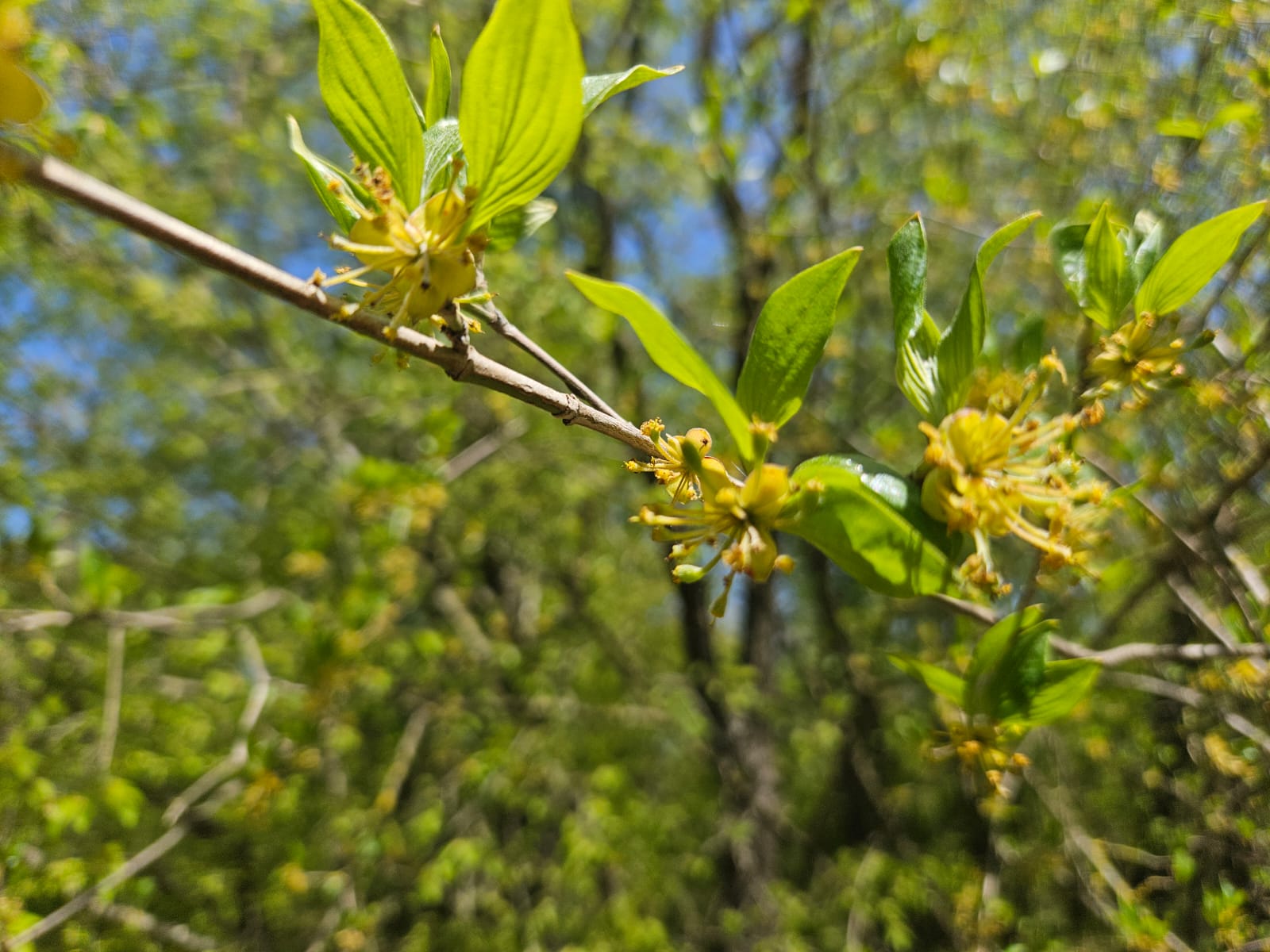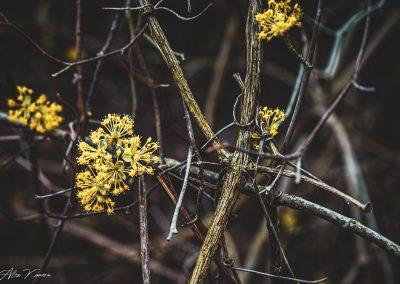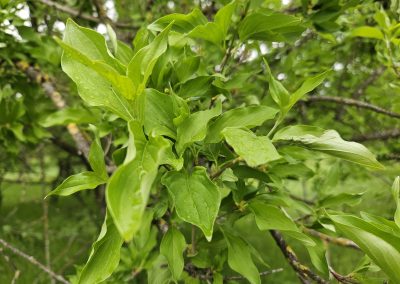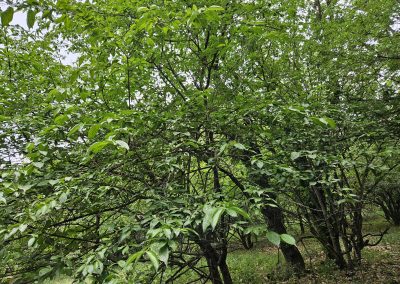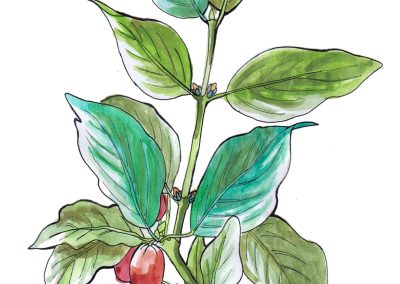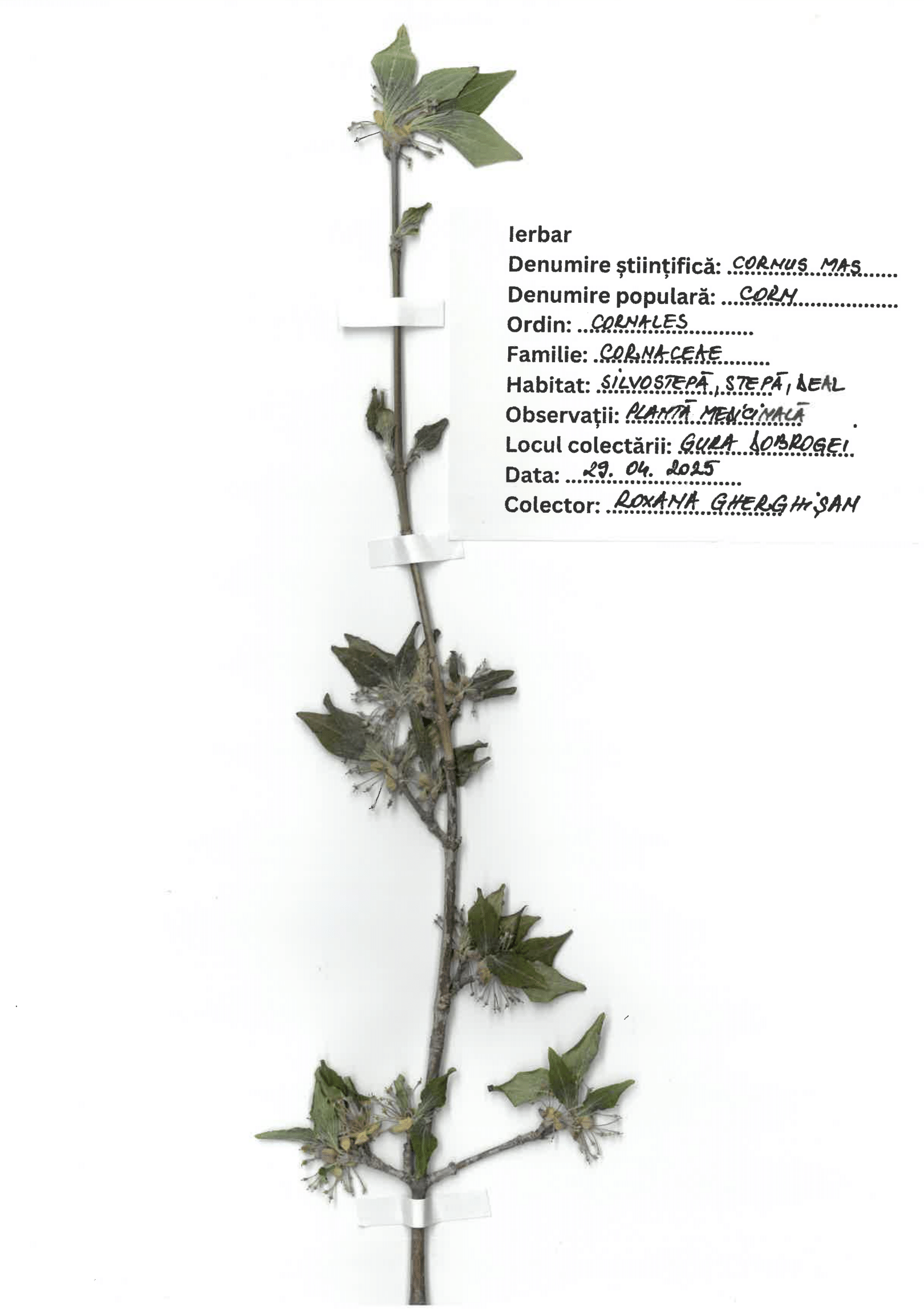Cornus Mas
Scientific description
Phylum: Angiospermatophyta (Magnoliophyta)
Class: Dicotyledonatae (Magnoliatae)
Subclass: Rosidae
Order: Cornales
Family: Cornaceae
Origin: Europe, Asia, the temperate zone of the northern hemisphere; Ponto-Mediterranean floristic element.
Description:
It is a shrub that can reach up to 8 m in height, with bark exfoliating in scales, red-purple, finely hairy, with a rare, bright crown. It has ovate-elliptical, acuminate, short-petiolate leaves, with 3-6 pairs of curved, pubescent lateral veins; in autumn they turn red. The yellow flowers are grouped in umbelliform, small, sessile cymes, surrounded by an involucre formed by 4 round bracts. It blooms in the spring long before the foliage.
Fruits: red or purple drupes, ripen in August-September and are edible, being used to make jam.
Propagation: By seed (August-September), cuttings or marcotage.
Ecology:
Spontaneous species growing in deciduous forests, prefers shady places with fertile humic soil and moderate humidity.
Use:
In parks and gardens, isolated or in groups, as an ornamental species; fruits edible.
Încrengătura: Angiospermatophyta (Magnoliophyta)
Clasa: Dicotyledonatae (Magnoliatae)
Subclasa: Rosidae
Ordinul: Cornales
Familia: Cornaceae
Origine: Europa, Asia, zona temperată a emisferei nordice; element floristic ponto-mediterranean.
Denumire populară: corn
Descrierea:
Arbust care poate ajunge până la 8 m, cu scoarța exfoliantă în solzi, lujeri roșii–purpurii, fin păroși, cu coronament rar, luminos. Frunze ovat-eliptice, acuminate, scurt-pețiolate, cu 3-6 perechi de nervuri laterale curbate, pubescente; toamna se înroșesc. Florile galbene sunt grupate în cime umbeliforme, mici, sesile, înconjurate de 4 bractee rotunde. Înflorește primăvara, mult înaintea înfrunzirii.
Fructele: drupe roșii sau purpurii, se coc în august-septembrie, comestibile, folosite la gem și dulceață.
Înmulțirea: prin sămânță (august-septembrie), butași sau marcotaj.
Ecologia:
Specie spontană în pădurile de foioase, preferă locurile umbroase, solul humic fertil și umiditate moderată.
Utilizare:
În parcuri și grădini, ca ornamental, izolat sau în grupuri; fructele pentru alimentația umană, dulceață, cornată.
Pericol: Lemnul este tare și omogen, căutat în tâmplărie.
Γένος: Angiospermatophyta (Magnoliophyta)
Τάξη: Dicotyledonatae (Magnoliatae)
Υποκατηγορία: Rosidae
Τάξη: Cornales
Οικογένεια: Cornaceae
Καταγωγή: Ευρώπη, Ασία, εύκρατη ζώνη του βόρειου ημισφαιρίου.
Δημοφιλές όνομα: cornel
Περιγραφή:
Θάμνος έως 8 μ., με φλοιό που απολεπίζεται σε φολίδες, κοκκινωπό-πορφυρό, λεπτότριχο, με αραιή, φωτεινή κόμη. Φύλλα ωοειδή-ελλειπτικά, οξύληκτα, βραχύμισχα, με 3-6 ζεύγη καμπύλων πλευρικών νευρώσεων, εφηβικά· το φθινόπωρο κοκκινίζουν. Τα κίτρινα άνθη σε μικρές άμισχες σκιάδες με 4 βράκτια. Ανθίζει την άνοιξη πριν τη φυλλοφορία.
Καρποί: κόκκινα ή μοβ δρύπες, ωριμάζουν Αύγουστο-Σεπτέμβριο, βρώσιμες (μαρμελάδα).
Πολλαπλασιασμός: με σπόρους (Αύγουστος-Σεπτέμβριος), μοσχεύματα ή καταβολάδες.
Οικολογία:
Αυθόρμητο είδος σε φυλλοβόλα δάση· προτιμά σκιερές θέσεις με γόνιμο χουμικό έδαφος και μέτρια υγρασία.
Χρήση:
Σε πάρκα και κήπους, μεμονωμένα ή σε ομάδες, ως καλλωπιστικό· καρποί βρώσιμοι.
Κίνδυνος: ξύλο σκληρό και ομοιογενές, περιζήτητο στην ξυλουργική.
Embranchement: Angiospermatophyta (Magnoliophyta)
Classe: Dicotyledonatae (Magnoliatae)
Sous-classe: Rosidae
Ordre: Cornales
Famille: Cornaceae
Origine: Europe, Asie, zone tempérée de l’hémisphère nord; élément floristique ponto-méditerranéen.
Description:
Arbuste pouvant atteindre 8 m, à écorce exfoliante en écailles, rouge-pourpre, finement velue, couronne rare et brillante. Feuilles ovales-elliptiques, acuminées, courtement pétiolées, 3-6 paires de nervures latérales pubescentes, devenant rouges en automne. Fleurs jaunes en petites cymes ombelliformes sessiles avec 4 bractées rondes. Floraison printanière avant le feuillage.
Fruits: drupes rouges ou pourpres, mûrissent août-septembre, comestibles (confitures).
Multiplication: graines (août-septembre), boutures ou marcottage.
Écologie:
Espèce spontanée des forêts feuillues, préfère lieux ombragés, sols humifères fertiles et humidité modérée.
Utilisation:
Espèce ornementale en parcs et jardins; fruits comestibles.
Creative writing inspired by Cornus Mas
Written by Andreea Tote
The Legend of the Cornelian Cherry
Long ago, in the lands that stretched between Greece and the Balkans, there was a tree whose blossoms marked the arrival of spring long before other flowers dared to bloom. The Cornus mas, or Cornelian cherry, stood as a silent witness to the changing seasons, its tiny yellow flowers appearing as early as February, its leaves still a dream in the distance. These delicate, sun-kissed blossoms covered the bare wood directly, making the tree a sight to behold against the backdrop of a still-winter landscape. As time passed, its fruits—small, red, and edible—would ripen, offering a tart, sweet taste, used to create jams, syrups, and refreshing drinks.
The people of ancient Greece knew the tree well, for its wood was revered for its strength and resilience. Legends whispered that even the Trojan Horse and the mighty bow of Odysseus were crafted from the sturdy branches of the Cornus mas. Homer himself spoke of the tree in his epics, and one legend, in particular, would forever intertwine the tree with both loss and immortality.
Polydorus, son of the King of Troy, met a tragic end in battle. It was said that he was killed with spears made of Cornus mas wood. Where his blood touched the earth, a Cornelian tree grew in his memory. Centuries later, as Aeneas fled the burning city of Troy, he sought shelter and firewood, unaware of the significance of the land beneath his feet. When he broke a branch of the tree, blood spilled, and the spirit of Polydorus appeared, tying the Cornus mas not only to human life but to the divine presence that watched over the souls of the fallen.
In the heart of Roman mythology, the Cornelian cherry was seen as a symbol of strength and destiny. Romulus, the legendary founder of Rome, stood on the heights of Mount Aventine, watching over his fledgling city. With a mighty throw, he hurled a spear into the earth, and where it struck, a Cornus mas tree took root, a living testament to the resilience of Rome itself. From that moment on, the tree was intertwined with the spirit of the city—strong, steadfast, and ever-growing.
The Cornus mas also earned favor with Philip II of Macedonia, father of the great Alexander the Great. Recognizing the strength of the wood, Philip equipped his warriors with weapons made from its dense branches—bows, lances, and arrows. These weapons, he believed, would lead his army to victory. Indeed, for centuries, the wood of the Cornus mas became an essential tool in the art of warfare.
But the Cornus mas was not merely a symbol of battle and conquest. In the Balkans, its fruits and wood were steeped in love and devotion. One such tale tells of a young man who, in his quest to win the heart of his beloved, journeyed deep into the forest to find a rare fruit—the shining red cornites. He returned to her, presenting the fruit as a token of his love, and she, moved by his dedication, accepted his hand in marriage. From that moment on, the tree became a symbol of devotion and heartfelt gifts, planted near homes to protect against misfortune and bring luck, especially at the start of a new year.
Though once believed to be poisonous, the Cornus mas is now recognized for its medicinal value, with its fruits offering a healing touch. And though the tree may still be seen as a lucky charm for those who seek it out, its true magic lies not only in its strength or its gifts, but in the way it has captured the hearts and imaginations of all who have known its story.
From ancient Greece to the forests of the Balkans, the Cornus mas stands as a symbol of resilience, love, and the eternal cycle of life—a tree that blooms not only in spring but in the hearts of those who believe in the strength of legend.


